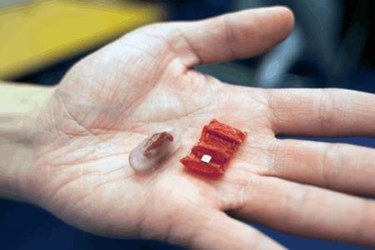Ingestible Origami Robot Unfolds In Stomach

An international team of scientists centered at MIT have further developed a tiny ingestible robot that unfolds from a capsule once swallowed, and could be used to retrieve foreign objects or patch wounds. New additions to the design include a more biocompatible material and structural modifications that allow the device to be compressed into a swallowable capsule.
Daniela Rus, director of the Computer Science and Artificial Intelligence Laboratory (CSAIL) at MIT, and her team have developed a number of prototypes of reconfigurable, printable robots that fold into precisely pre-determined shapes once heated. Since last year, Rus’s team has been working on modifications toward a device that could be injected into the body, navigate itself to an intervention site, and dissolve once its work is done.
The basic premise of their design uses a layer of material that shrinks when heated, sandwiched between two structural layers. Slits cut into the outer surface of the sheet-shaped device dictate the robot’s eventual shape once heat is applied. The team’s newest prototype, which was introduced at a conference hosted by the IEEE Robotics and Automation Society, made changes to the materials so that they could be compressed into a capsule and be more biocompatible, reported MIT News.
“The challenge with designing an ingestible robot is finding biocompatible materials that are easy to be controlled and are amenable for the types of operations that are needed from the robot,” said Rus in a YouTube video, adding that the team investigated dozens of biocompatible materials before settling on dried pig intestine.
The recent prototype was tested in a simulated stomach environment fashioned from silicone rubber and used lemon juice to simulate stomach acids. In experiments, the robot unfolded from an ice capsule and navigated using a self-propelled “stick-slip” motion, which allows the device to adhere to surfaces when it moves but slips free once the body flexes and the device’s weight is redistributed.
A centralized magnet allowed scientists to steer the device from the outside and retrieve a button battery that was lodged into the simulated tissue. According to researchers, 3,500 button batteries are swallowed every year, causing dangerous complications that require surgical intervention.
“It’s really exciting to see our small origami robots doing something with potential important applications to healthcare,” said Rus to MIT News. Eventually, Rus said she would like to do away with the battery and external navigation and add sensors, making a completely “untethered robot system” that is highly scalable.
“This concept is both highly creative and highly practical, and it addresses a clinical need in an elegant way,” said Bradley Nelson, a professor of robotics at the Swiss Federal Institute of Technology in Zurich, to MIT News. “It is one the most convincing applications of origami robots that I have seen.”
Another team from MIT recently introduced an ingestible device that can measure vital signs from inside the body, which scientists say could be used to monitor trauma patients without touching damaged skin. Scientists from Vanderbilt have open sourced robotic pill technology to jump-start research into potential applications of ingestible robotics.
